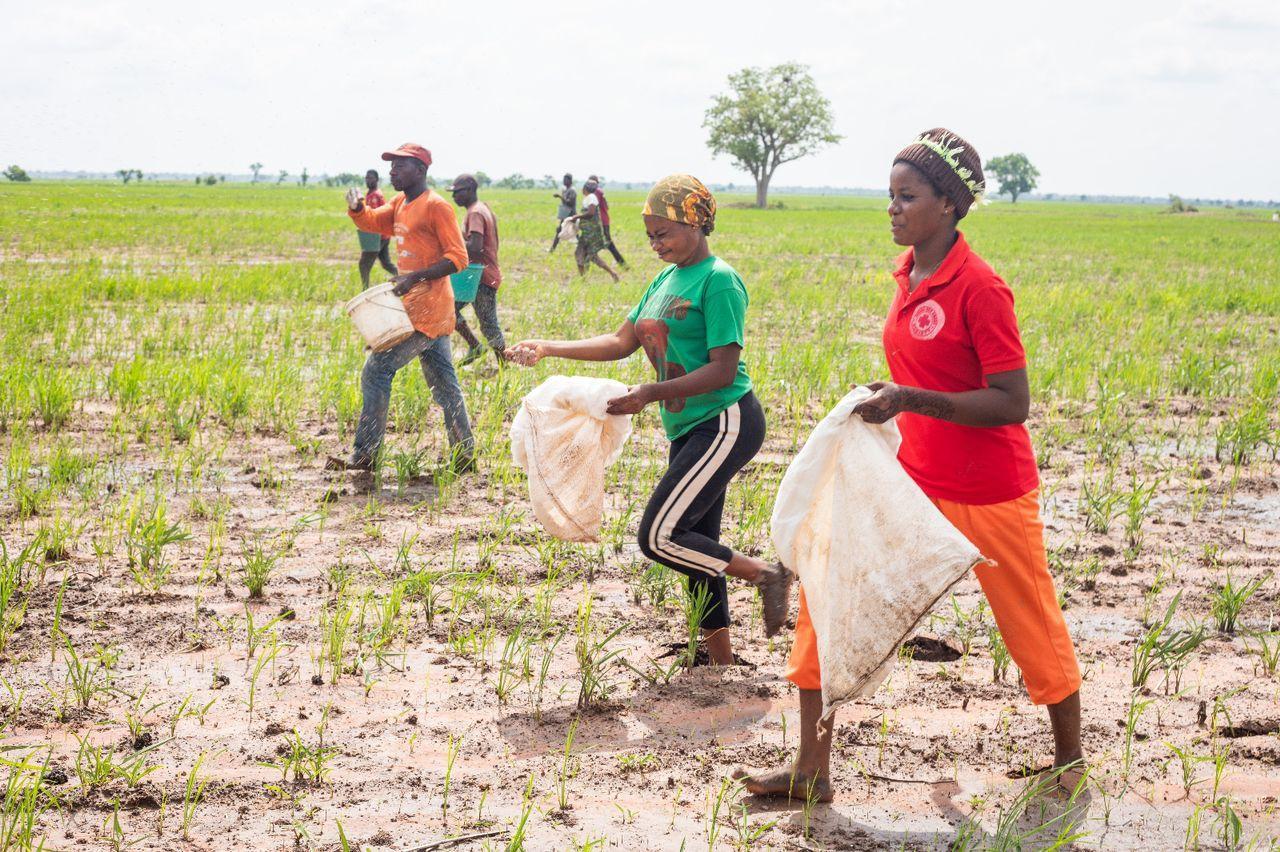Africa-Press – Ghana. Agriculture plays a vital role in improving livelihoods, especially in regions where it serves as the backbone of the economy.
Most households depend on income from agricultural activities to support their families and to make the needed investments in housing, healthcare, and education.
Agricultural diversification has proven to be a major driver for improving livelihoods. In most households in Ghana, a crop-and-livestock combination helps in meeting livelihood needs.
Examples
Ottoman Empire
In the 1800s the Ottoman Empire demonstrated how a holistic approach to agriculture drives wealth creation and transforms nations from purely agrarian economies to industrial nations and leading global trade powerhouses.
The Ottoman Empire demonstrates that agricultural reforms can be used to build resilience to international and domestic shocks.
The narrative for the Ottoman Empires highlights some facts that characterized their agrarian reforms.
Increased productivity resulting from irrigation, intensive agriculture and the use of modern agricultural tools and implements that characterized their agrarian reforms.
By the 1900s tens of thousands of farm implements such as ploughs, harrows, seeders, reapers, and machinery such as combine harvesters were found across the Balkan, Anatolian and Arab regions of the empire.
A major contributor to the increased production was the millions of hectares that were brought under crop cultivation because of proper land development, and input credit using the share cropping approach.
Along with state policy, millions of refugees brought vast tracts of untilled land into production.
Agricultural education and research coupled with irrigation, intensive agriculture, land development, modern technology drove agricultural productivity and production to the extent that the Ottoman Empire was resilient.
From 1876 to 1908, Anatolia’s agricultural exports increased by 45% and the proceeds by 79%.
India
India for over several decades from the late 1700s to the mid-1900s had been characterized with low agricultural productivity and famine with the Bengal Famine in the 1940s taking millions of lives.
To meet domestic food demand, India had to import about 10 million tons of grain annually and rationed these grains in the 1950s.
A holistic approach to agricultural modernization has culminated in India being a leading food exporter in the 21st century, exporting about 60 million tons of grain annually.
India experienced the Green Revolution through the effective implementation of some key policies in their agriculture sector.
The policies drove investments in coordinated research that introduced high-yielding crop varieties, increased use of fertilizers, irrigation development and mechanization.
These transformed Indian agriculture from a low productivity country, at independence with a track record of repeated famine, to a substantially high productivity country, in less than a decade.
India with a well-structured agriculture and rural development financing institution, in the form of the National Bank for Agriculture and Rural Development (NABARD), providing low-cost credit to Farmer Production Organizations (FPOs) in the early 1980s diversified agriculture from staples like rice and wheat to producing a wide range of fruits, vegetables, oil seeds, pulses and spices.
India by the turn of the 20th century had become a high-productivity agriculture country using modern technologies to produce a wide range of food items. The formation of the Agricultural and Processed Food Products Export Development Authority (APEDA) empowered private sector participation in food and agro-commodities driving value addition along the chain, creating enormous value for all actors.
Today India is a leading exporter of food, exporting USD 48.15 billion worth of food in the 2023-2024 fiscal year, an increase of 112% over the 2013-2014 fiscal year.
This strong and resilient growth in exports is attributed to consistent sector growth rates, due to the government’s initiatives to enhance productivity, promote crop diversification, and increase farmers’ income (Economic Survey 2024-25).
Brazil
Brazil today is a major player with global importance for both food security and environmental sustainability.
A country that was a net importer of food in the 1980s and a recipient of food aid in the 1960s, is today the the second largest food exporter by volume in the world. In 2024 Brazil’s agricultural exports reported by MAPA was USD 164 billion.
Brazil is well noted for science-based technological advancement in tropical agriculture that has created a modern and globally competitive commercial agriculture for all commodities including crops and livestock.
For instance, the research and entrepreneurial efforts of Brazilians have developed soybean varieties for the tropics, which can produce yields as high as (and maybe even higher than) those produced in temperate regions.
In conjunction with the efforts in genetic improvements, it was necessary to adopt novel agricultural practices and modern innovations, including fertilizers, agrochemicals, biological nitrogen fixation and no-till practices to transform the traditional farming environment into a modern highly productive and competitive agrifood system.
Certain policies were pivotal in transforming Brazilian agriculture from a traditional low input, low yields and non-competitive agriculture to an efficient, resource-saving, high return on investment and competitive agri-food system. An example, is the availability of subsidized financial credit, mainly for capital financing and for purchasing modern inputs.
The rural extension program in Brazil was part of the national development strategy and focused on modernization of its agriculture. Recent extension policies have focused on agribusiness-related activities that represent the significant part of Brazilian exports and contribute to the gross domestic product.
The establishment of the National Agricultural Research System, coordinated by the Brazilian Agricultural Research Corporation (Empresa Brasileira de Pesquisa Agropecuria; Embrapa) is yet another strategy. Embrapa is an innovation-driven company under Brazilian Ministry of Agriculture and Livestock (MAPA), that focuses on the generation and utilization of knowledge and technology for Brazilian agriculture. Infrastructural development in Brazil from the 1970 to 1980 when the bulk of investments were made focused on driving productivity and therefore was skewed to the municipalities that had the potential to drive productivity rather than the reallocation of labour and capital. Brazil’s infrastructure development involved prioritizing regions with the highest potential for economic growth and aligning investments with local needs and economic conditions rather than political considerations.
Trade liberalization: From the mid-1990s onwards, macroeconomic stability, better relative prices for agricultural commodities in the world markets, and the maturation of tropical agricultural technologies that had been generated in the preceding two decades provided the basis for a new era in Brazilian agribusiness.
The sector moved forward rapidly from a traditionally based agricultural system to one based on science and technology. The impact of these policies on food prices, productivity and production in Brazil from 1970s to date has been tremendous.
Ghana’s current approach to Agricultural Development
Ghana has been working at transforming its agriculture sector just like most African countries, guided by the national Medium-Term Development Framework. It also domesticates international development frameworks such as the Sustainable Development Goals (SDGs) at the global level; the Comprehensive African Agricultural Development (CAADP)-Malabo declaration at the continental level; and the ECOWAS Agricultural Policy (ECOWAP) at the regional level. These development frameworks are all too generic and very broad and have not been able to transform agriculture over the almost two decades of CAADP implementation of investing 10% of the national budget to drive 6% growth in agriculture.
Agricultural transformation faces many challenges that demand a policy shift toward streamlined, inclusive practices with clear accountability mechanisms, free from excessive bureaucracy, silo-sitting, and quick fixes.
A persistent pattern emerges despite heavy investments and the adoption of ambitious frameworks; the sustainability of progress remains precarious.
The disconnect between project-based interventions and long-term institutional change has contributed to an ongoing cycle where critical infrastructure and hard-won advancements lose momentum or fall into disrepair.
This cyclical challenge is exacerbated by insufficient follow-through, limited stakeholder buy-in at the local level, and a lack of continuity in leadership and resource allocation.
To make meaningful progress, Ghana must confront these entrenched obstacles by fostering greater collaboration across sectors, strengthening accountability, and tailoring policies to the unique contexts of its diverse agricultural zones. Flexible governance models, rooted in evidence-based practices and informed by data collected at the grassroots level, are essential for bridging the gap between intentions and outcomes. These were realized through the consistent review of the policies and programs from a focus on technological innovation to a focus extension and credit to drive productivity and production and finally to diversification and trade liberation driving exports
The way to go
Looking ahead, Ghana’s agricultural future depends on a clear break from the patterns of ephemeral programming.
Rather than allowing gains to dissipate at the end of each project cycle, there must be a strategic pivot toward resilience and institutional learning.
This involves reimagining agricultural development as a continuous process—one where the knowledge, infrastructure, and capacity built over time are not merely preserved but actively enhanced.
At the same time, successful transformation of the Ghanaian economy driven by agricultural development will require commitment at every level: from government agencies harmonizing their objectives and eliminating redundancies, to local communities owning and sustaining progress, to the private sector providing innovative financing and market opportunities.
Only through a culture of shared responsibility, continual assessment, and adaptive leadership can Ghana hope to realize the true potential of its agricultural sector.
In considering pathways for Ghana’s own agricultural transformation, the Brazilian experience offers valuable insight.
The deliberate alignment of infrastructural investments with areas of highest growth potential, as well as the integration of research, technology, differentiated credit, and targeted policy reform, catalyzed Brazil’s leap in productivity and international competitiveness. This approach not only spurred output but also intentionally saved land and boosted efficiency, demonstrating that well-coordinated policies and capacity-building institutions are essential to support sustained agricultural advancement.
When reflecting on Ghana’s journey, the opportunity lies in adapting such integrated, innovation-driven strategies, focusing on resolving bottlenecks, investing in research capacity, and fostering environments where policy, implementation, and accountability are seamlessly connected. By learning from Brazil and India’s systemic transformation, Ghana can move toward building a resilient, high-performing agricultural sector that responds dynamically to both domestic needs and global market shifts.
Five Necessary Policies
Coordinated National Agricultural Research
Coordinated national agriculture systems with the singular objective to enhancing agricultural productivity and efficient resource utilization under the auspices of the Ministry of Food and Agriculture is a necessity for Ghana’s agriculture.
Establishing a cohesive national agricultural research framework is crucial for driving innovation, improving productivity, and ensuring that interventions are evidence-based and tailored to Ghana’s unique agro-ecological zones. By investing in research institutions and fostering collaboration between academia, government, and the private sector, the country can accelerate the development and dissemination of context-specific technologies, best practices, and resilient crop varieties.
Such an approach will also set the stage for adaptive responses to future risks, including climate change and evolving market demands.
A Differentiated Agricultural Credit System
Ghana should prioritize the establishment of tailored financial instruments that align disbursement schedules with agricultural calendars, standardize the loan application process, and introduce safeguards to ensure funds are utilized as intended. Strengthening partnerships between financial institutions, agribusinesses, and farmer associations can further reduce risk and facilitate access to affordable credit, enabling producers to invest in inputs and technology that drive productivity and profitability. Additionally, partnerships with specialized non-bank financial institutions and financial technology providers can help streamline access to credit, improve transparency, and ensure that funds are utilized efficiently for productive investments. Credit schemes must be closely aligned with crop calendars and production cycles, offering flexible repayment terms and technical support to reduce default risks.
A Modern Agricultural Extension System
A robust and responsive agricultural extension system is fundamental to bridging the gap between research, credit, and on-the-ground farming practices. Ghana must revamp its extension services to ensure that farmers receive timely, relevant, and actionable information tailored to their specific crop and livestock systems. Leveraging digital platforms, mobile advisory services, and decentralized extension agents can enhance outreach, while training and capacity-building should empower extension workers to use digital platforms and e-extension to deliver up-to-date guidance. By fostering closer collaboration between extension services, research institutions, financial institutions and farmer groups, Ghana can accelerate the adoption of innovative practices, improve yields, and strengthen resilience to environmental and market changes.
Structured Farmer Organizations
To further ensure the effective translation of policy and research into tangible outcomes for farmers, Ghana must prioritize the development and support of structured farmer organizations. These groups serve as critical conduits for information, collective bargaining, and resource sharing, empowering farmers to advocate for their interests and access essential inputs and markets. Strengthening farmer organizations can also facilitate the dissemination of best practices, enhance transparency in value chains, and foster stronger linkages between producers, processors, and buyers. Ultimately, well-structured farmer organizations will underpin efforts to scale innovation and drive inclusive growth across the agricultural sector.
Structured Market Arrangements
Creating structured market arrangements is another key policy necessary for Ghana’s agricultural transformation. By developing transparent, predictable, and accessible market systems—such as contract farming, commodity exchanges, and aggregation centers—farmers can secure fair prices, reduce post-harvest losses, and reliably connect with buyers both locally and internationally. These arrangements mitigate market risks and incentivize quality production, while also attracting private investment and supporting value addition. Well-established market structures will make Ghanaian agriculture more competitive and resilient, giving producers the confidence to innovate and expand.
These policies, when thoughtfully designed and executed, can serve as the backbone for Ghana’s agricultural transformation. By integrating research, credit, extension services, farmer organization, and structured market systems into a coherent framework, stakeholders can unlock synergies that multiply impact across the value chain. Strategic collaboration among government, private sector, and communities will be essential in driving adoption, scaling solutions, and ensuring sustainability. The path forward requires not only policy innovation but also operational excellence and inclusive participation to build a vibrant agricultural future for Ghana.
Enablers
The proposed policies for agricultural modernization as a driver for economic transformation require essential enablers (i.e., critical foundational elements for successful implementation) to support and sustain this integrated model. These include investments in land development for mechanization, efficient component assembling of farm machinery and equipment, sustainable energy solutions, and robust transportation and communication networks. Additionally, the adoption of rigorous public-private partnership monitoring and evaluation mechanisms ensures that all interventions are aligned with sector goals and responsive to stakeholder needs.
These enablers form the foundational infrastructure and operational capacities that allow the policy to be implemented effectively, fostering synergy across the value chain. Without such underpinning assets—ranging from physical infrastructure to technology and logistics—the efficiency and resilience of the system would be compromised. By prioritizing these enablers, Ghana can foster an environment in which innovation thrives, and agricultural productivity is optimized.
Ultimately, a holistic integration of these foundational enablers paves the way for a resilient, competitive, and inclusive Ghanaian agricultural sector. By building upon these pillars, the nation can unlock new opportunities for rural prosperity, drive sustained economic transformation, and secure food systems for future generations.
For More News And Analysis About Ghana Follow Africa-Press







